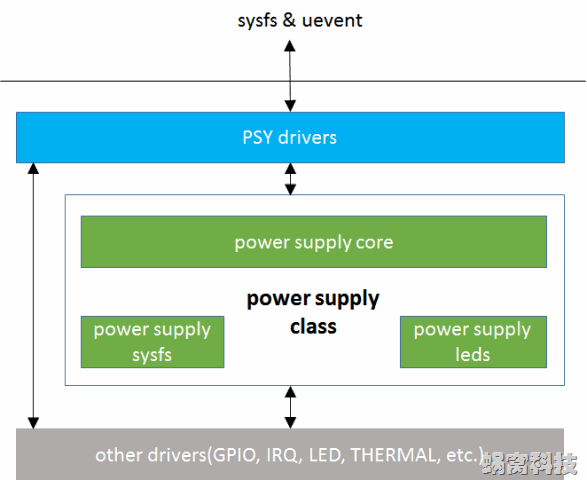Linux Power supply子系统分析之一
转自:http://www.wowotech.net/pm_subsystem/psy_class_overview.html
1.概述
对于便携式设备,如手机或者pad来说,battery都是必不可少的一个组成部分。kernel中为了方便对battery的管理,专门提供了power supply framework。battery管理我觉得可以分开为两个部分,一个是电池监控(fuelgauge),另一个是充放电管理(charger),所以我们在内核中也是把它分成了两个驱动来管理。fuelgauge驱动主要是负责向上层android系统提供当前电池的电量以及健康状态信息等等,另外除了这个以外,它也向charger驱动提供电池的相关信息;charger驱动主要负责电源线的插拔检测,以及充放电的过程管理。对于battery管理,硬件上有电量计IC和充放电IC。
2.Power Supply设计思路
先来回答一个问题:kernel中设备驱动的目的,是管理设备,并提供给用户空间程序使用,那么对PSY设备而言,kernel要管理什么?用户空间程序要使用什么?
其实PSY设备是一个特例,它的目的很单纯,就为系统供电。如果只考虑这个目的,就不需要任何驱动了,但情况会稍微复杂,因为:
1.PSY设备可能是电池,这引申出来电量检测, 充电管理等多个议题。此时,PSY driver需要管理的事情包括:检测电池类型,检测电池电量;检测充电状态等等。而用户空间则需要将检测到的结果显示给用户。
2.系统中可能有多个PSY设备,这些设备可能还有级联关系,如有些平板电脑中,可能同时存在DC-charger、USB-charger和battery供电。此时,PSY driver需要管理的事情包括,获取外部供电设备的连接状态,充电状态等等,用户空间需要将这些信息显示给用户。
那么,共性已经总结出来了,PSY driver的主要功能,就是向用户空间汇报各类状态信息,因此power supply class的核心思路就是:
将这些状态信息,抽象为属性“properties”。由于状态信息是类型是有限的,properties的个数也是有限的。
PSY driver只需要负责:该PSY设备具备有哪些“属性”,这些“属性”的值(value)是什么;当属性值发生改变时,通知power supply class。
power supply class负责:将某个PSY 设备支持的属性及value,以sysfs的形式,提供给用户空间,当属性值改变时,以uevent的形式,广播给用户空间程序。
另外,power supply class也会协助处理PSY级联的情况。
3.Power Supply软件架构
power supply framework在kernel/drivers/power/下。内核抽象出来power supply子系统为驱动提供了统一的框架。功能包括:1.抽象PSY设备的共性,向用户空间提供统一的API
2.为底层PSY驱动的编写,提供简单、统一的方式。同事封装并实现公共逻辑。
power supply class位于drivers/power/目录中,主要由3部分组成(可参考下图的软件架构):
1)power supply core,用于抽象核心数据结构、实现公共逻辑。位于drivers/power/power_supply_core.c中。
2)power supply sysfs,实现sysfs以及uevent功能。位于drivers/power/power_supply_sysfs.c中。
3)power supply leds,基于linux led class,提供PSY设备状态指示的通用实现。位于drivers/power/power_suppply_leds.c中。
最后,驱动工程师可以基于power supply class,实现具体的PSY drivers,主要处理平台相关、硬件相关的逻辑。这些drivers都位于drivers/power/目录下。
接着来看一下核心数据结构
1.struct power_supply
struct power_supply为power supply class的核心数据结构,用于抽象PSY设备,定义如下:
struct power_supply {
const char *name; //该PSY的名称
enum power_supply_type type; //该PSY的类型,枚举类型,一般包括:battery、USB-charger、DC-charger。
enum power_supply_property *properties; //该PSY具有的属性列表,枚举型。
size_t num_properties; //属性的个数
char **supplied_to; //一个字符串数组,保存了由该PSY供电的PSY列表,以此可将PAY组成互相级联的PSY链表。这些被供电的PSY,称作supplicant(客户端,乞求者)
size_t num_supplicants;//supplicant的个数。
char **supplied_from; //一个字符串数组,保存了该PSY供电的PSY列表,也称作supply(提供者),从另外一个方向组织PSY之间的级联关系。
size_t num_supplies; //supply的个数
#ifdef CONFIG_OF
struct device_node *of_node; //用于保存of_node指针。
#endif
int (*get_property)(struct power_supply *psy, //PSY driver需要实现的回调函数,用于获取属性值。
enum power_supply_property psp,
union power_supply_propval *val);
int (*set_property)(struct power_supply *psy, //PSY driver需要实现的回调函数,用于设置属性值。
enum power_supply_property psp,
const union power_supply_propval *val);
int (*property_is_writeable)(struct power_supply *psy, //返回指定的属性值是否可写(用于sysfs);
enum power_supply_property psp);
void (*external_power_changed)(struct power_supply *psy); //当一个PSY设备存在supply PSY,且该supply PSY的属性发生改变(如online offline)时,power supply core会调用该回调函数,通知PSY driver以便让它做出相应处理。
void (*set_charged)(struct power_supply *psy); //该回调函数的应用场景有点奇怪,外部模块通知PAY driver,该PSY设备的状态改变了,自己改变了自己不知道,要外部通知,希望大家在实际工作中不要遇到,太纠结了。
/* For APM emulation, think legacy userspace. */
int use_for_apm;
/* private */
struct device *dev;
struct work_struct changed_work; //用户处理状态改变的work queue,主要思路是当该PSY的状态发生改变,启动一个workqueue,查询并通知所有的supplicants。
spinlock_t changed_lock;
bool changed;
#ifdef CONFIG_THERMAL
struct thermal_zone_device *tzd;
struct thermal_cooling_device *tcd;
#endif
#ifdef CONFIG_LEDS_TRIGGERS
struct led_trigger *charging_full_trig;
char *charging_full_trig_name;
struct led_trigger *charging_trig;
char *charging_trig_name;
struct led_trigger *full_trig;
char *full_trig_name;
struct led_trigger *online_trig; //如果配置了CONFIC_LED_TRIGGERS,则调用的linux led class的接口,注册相应的LED设备,用于PSY状态指示。
char *online_trig_name;
struct led_trigger *charging_blink_full_solid_trig;
char *charging_blink_full_solid_trig_name;
#endif
};2.PSY的类型
PSY类型由enum power_supply_type定义:
enum power_supply_type {
POWER_SUPPLY_TYPE_UNKNOWN = 0, //未知
POWER_SUPPLY_TYPE_BATTERY, //电池,手机平板上面最常用的
POWER_SUPPLY_TYPE_UPS, //不间断供电的,一般用户服务器
POWER_SUPPLY_TYPE_MAINS, //主供电设备,如笔记本电脑适配器,特点是可以单独供电,当其断开时,再由辅助设备供电。
POWER_SUPPLY_TYPE_USB, /* Standard Downstream Port */
POWER_SUPPLY_TYPE_USB_DCP, /* Dedicated Charging Port */
POWER_SUPPLY_TYPE_USB_CDP, /* Charging Downstream Port */
POWER_SUPPLY_TYPE_USB_ACA, /* Accessory Charger Adapters */
};
3.PSY属性
power supply class将所有可能PSY属性,以枚举型变量形式抽象出来,PSY driver可以根据设备的实际情况,从中选取一些。
enum power_supply_property {
/* Properties of type `int' */
POWER_SUPPLY_PROP_STATUS = 0, //该PSY的status,主要是充电状态,包括:unknown,charging,discharging,not charging full,
POWER_SUPPLY_PROP_CHARGE_TYPE,//充电类型
POWER_SUPPLY_PROP_HEALTH, //健康状况,包括:good dead over voltage等
POWER_SUPPLY_PROP_PRESENT, //电量百分比
POWER_SUPPLY_PROP_ONLINE, //是否在线
POWER_SUPPLY_PROP_AUTHENTIC,
POWER_SUPPLY_PROP_TECHNOLOGY, //采用的技术
POWER_SUPPLY_PROP_CYCLE_COUNT,
POWER_SUPPLY_PROP_VOLTAGE_MAX,
POWER_SUPPLY_PROP_VOLTAGE_MIN,
POWER_SUPPLY_PROP_VOLTAGE_MAX_DESIGN,
POWER_SUPPLY_PROP_VOLTAGE_MIN_DESIGN,
POWER_SUPPLY_PROP_VOLTAGE_NOW,
POWER_SUPPLY_PROP_VOLTAGE_AVG,
POWER_SUPPLY_PROP_VOLTAGE_OCV,
POWER_SUPPLY_PROP_CURRENT_MAX,
POWER_SUPPLY_PROP_CURRENT_NOW,
POWER_SUPPLY_PROP_CURRENT_AVG,
POWER_SUPPLY_PROP_POWER_NOW,
POWER_SUPPLY_PROP_POWER_AVG,
POWER_SUPPLY_PROP_CHARGE_FULL_DESIGN,
POWER_SUPPLY_PROP_CHARGE_EMPTY_DESIGN,
POWER_SUPPLY_PROP_CHARGE_FULL,
POWER_SUPPLY_PROP_CHARGE_EMPTY,
POWER_SUPPLY_PROP_CHARGE_NOW,
POWER_SUPPLY_PROP_CHARGE_AVG,
POWER_SUPPLY_PROP_CHARGE_COUNTER,
POWER_SUPPLY_PROP_CONSTANT_CHARGE_CURRENT,
POWER_SUPPLY_PROP_CONSTANT_CHARGE_CURRENT_MAX,
POWER_SUPPLY_PROP_CONSTANT_CHARGE_VOLTAGE,
POWER_SUPPLY_PROP_CONSTANT_CHARGE_VOLTAGE_MAX,
POWER_SUPPLY_PROP_CHARGE_CONTROL_LIMIT,
POWER_SUPPLY_PROP_CHARGE_CONTROL_LIMIT_MAX,
POWER_SUPPLY_PROP_ENERGY_FULL_DESIGN,
POWER_SUPPLY_PROP_ENERGY_EMPTY_DESIGN,
POWER_SUPPLY_PROP_ENERGY_FULL,
POWER_SUPPLY_PROP_ENERGY_EMPTY,
POWER_SUPPLY_PROP_ENERGY_NOW,
POWER_SUPPLY_PROP_ENERGY_AVG,
POWER_SUPPLY_PROP_CAPACITY, /* in percents! */
POWER_SUPPLY_PROP_CAPACITY_ALERT_MIN, /* in percents! */
POWER_SUPPLY_PROP_CAPACITY_ALERT_MAX, /* in percents! */
POWER_SUPPLY_PROP_CAPACITY_LEVEL, //容量
POWER_SUPPLY_PROP_TEMP,
POWER_SUPPLY_PROP_TEMP_ALERT_MIN,
POWER_SUPPLY_PROP_TEMP_ALERT_MAX,
POWER_SUPPLY_PROP_TEMP_AMBIENT,
POWER_SUPPLY_PROP_TEMP_AMBIENT_ALERT_MIN,
POWER_SUPPLY_PROP_TEMP_AMBIENT_ALERT_MAX,
POWER_SUPPLY_PROP_TIME_TO_EMPTY_NOW,
POWER_SUPPLY_PROP_TIME_TO_EMPTY_AVG,
POWER_SUPPLY_PROP_TIME_TO_FULL_NOW,
POWER_SUPPLY_PROP_TIME_TO_FULL_AVG,
POWER_SUPPLY_PROP_TYPE, /* use power_supply.type instead */
POWER_SUPPLY_PROP_SCOPE,
/* Local extensions */
POWER_SUPPLY_PROP_USB_HC,
POWER_SUPPLY_PROP_USB_OTG,
POWER_SUPPLY_PROP_CHARGE_ENABLED,
/* Local extensions of type int64_t */
POWER_SUPPLY_PROP_CHARGE_COUNTER_EXT,
/* Properties of type `const char *' */
POWER_SUPPLY_PROP_MODEL_NAME,
POWER_SUPPLY_PROP_MANUFACTURER,
POWER_SUPPLY_PROP_SERIAL_NUMBER,
};4.向具体的PSY driver提供的API
power supply class 首要任务,是向PSY driver提供统一的驱动编程接口,主要包括:
1.PSY 的register/unregister API
extern int power_supply_register(struct device *parent,
struct power_supply *psy);
extern void power_supply_unregister(struct power_supply *psy);
extern int power_supply_powers(struct power_supply *psy, struct device *dev);2.PSY状态改变时通知power supply core的API
extern void power_supply_changed(struct power_supply *psy);当PSY driver检测到该设备某些属性改变时,需要调用这个接口,通知power supply core,power supply core会有如下动作
如果该PSY是其他PSY的供电源,调用这些PSY的external_power_changed回调函数,通知他们(这些PSY具体要做什么,由他们自身的逻辑决定);
发生notifier通知那些关心PSY设备状态的drivers;
以统一的格式向用户空间发送uevent。(这就是设备模型中ckass的魅力,对外接口由class core提供,可以节省driver的工作量,同时确保了接口的一致性)。
3.其他杂项接口
extern struct power_supply *power_supply_get_by_name(const char *name); //通过名字获取PSY指针
extern int power_supply_am_i_supplied(struct power_supply *psy);//查询自己是否由其他PSY供电
extern int power_supply_set_battery_charged(struct power_supply *psy);//调用指定的PSY的set_changed回调。
extern int power_supply_is_system_supplied(void); //检查系统中是否有有效的或者处于online状态的PSY,如果没有,可能为桌面系统、
extern int power_supply_powers(struct power_supply *psy, struct device *dev);//在指定的设备的sysfs目录下创建指定的PSY符合连接。4.向用户空间提供的API
power supply class通过两种形式向用户空间提供接口。
(1)uevent,以“名字=value”的形式,上报所有property的值,格式如下:
POWER_SUPPLY_NAME=xxx /* power supply name */
POWER_SUPPLY_xxx1=xxx /* property = value */
POWER_SUPPLY_xxx2=xxx uevent一般会在PSY设备添加到kernel时,或者PSY属性发生改变时发生。
(2)sysfs
power supply class在power_supply_class.c中,定义了相当多的默认attribute,如果某个PSY设备具有某个属性,该属性对应的attribute就会体现在sysfs中(一般位于“/sys/class/power_suooly/xxx/”中)
/* Must be in the same order as POWER_SUPPLY_PROP_* */
static struct device_attribute power_supply_attrs[] = {
/* Properties of type `int' */
POWER_SUPPLY_ATTR(status),
POWER_SUPPLY_ATTR(charge_type),
POWER_SUPPLY_ATTR(health),
POWER_SUPPLY_ATTR(present),
POWER_SUPPLY_ATTR(online),
POWER_SUPPLY_ATTR(authentic),
POWER_SUPPLY_ATTR(technology),
POWER_SUPPLY_ATTR(cycle_count),
POWER_SUPPLY_ATTR(voltage_max),
POWER_SUPPLY_ATTR(voltage_min),
POWER_SUPPLY_ATTR(voltage_max_design),
POWER_SUPPLY_ATTR(voltage_min_design),
POWER_SUPPLY_ATTR(voltage_now),
POWER_SUPPLY_ATTR(voltage_avg),
POWER_SUPPLY_ATTR(voltage_ocv),
POWER_SUPPLY_ATTR(current_max),
POWER_SUPPLY_ATTR(current_now),
POWER_SUPPLY_ATTR(current_avg),
POWER_SUPPLY_ATTR(power_now),
POWER_SUPPLY_ATTR(power_avg),
POWER_SUPPLY_ATTR(charge_full_design),
POWER_SUPPLY_ATTR(charge_empty_design),
POWER_SUPPLY_ATTR(charge_full),
POWER_SUPPLY_ATTR(charge_empty),
POWER_SUPPLY_ATTR(charge_now),
POWER_SUPPLY_ATTR(charge_avg),
POWER_SUPPLY_ATTR(charge_counter),
POWER_SUPPLY_ATTR(constant_charge_current),
POWER_SUPPLY_ATTR(constant_charge_current_max),
POWER_SUPPLY_ATTR(constant_charge_voltage),
POWER_SUPPLY_ATTR(constant_charge_voltage_max),
POWER_SUPPLY_ATTR(charge_control_limit),
POWER_SUPPLY_ATTR(charge_control_limit_max),
POWER_SUPPLY_ATTR(energy_full_design),
POWER_SUPPLY_ATTR(energy_empty_design),
POWER_SUPPLY_ATTR(energy_full),
POWER_SUPPLY_ATTR(energy_empty),
POWER_SUPPLY_ATTR(energy_now),
POWER_SUPPLY_ATTR(energy_avg),
POWER_SUPPLY_ATTR(capacity),
POWER_SUPPLY_ATTR(capacity_alert_min),
POWER_SUPPLY_ATTR(capacity_alert_max),
POWER_SUPPLY_ATTR(capacity_level),
POWER_SUPPLY_ATTR(temp),
POWER_SUPPLY_ATTR(temp_alert_min),
POWER_SUPPLY_ATTR(temp_alert_max),
POWER_SUPPLY_ATTR(temp_ambient),
POWER_SUPPLY_ATTR(temp_ambient_alert_min),
POWER_SUPPLY_ATTR(temp_ambient_alert_max),
POWER_SUPPLY_ATTR(time_to_empty_now),
POWER_SUPPLY_ATTR(time_to_empty_avg),
POWER_SUPPLY_ATTR(time_to_full_now),
POWER_SUPPLY_ATTR(time_to_full_avg),
POWER_SUPPLY_ATTR(type),
POWER_SUPPLY_ATTR(scope),
/* Local extensions */
POWER_SUPPLY_ATTR(usb_hc),
POWER_SUPPLY_ATTR(usb_otg),
POWER_SUPPLY_ATTR(charge_enabled),
/* Local extensions of type int64_t */
POWER_SUPPLY_ATTR(charge_counter_ext),
/* Properties of type `const char *' */
POWER_SUPPLY_ATTR(model_name),
POWER_SUPPLY_ATTR(manufacturer),
POWER_SUPPLY_ATTR(serial_number),
};5.怎样基于power supply class编写PSY driver
最后从PSY driver的角度,说明一下怎么基于power supply class编写驱动:
(1)根据硬件spec,确定PSY设备具备哪些特性,并把他们和enum power_supply_property对应。
(2)根据实际情况,实现这些properties的get/set接口。
(3)定义一个struct power_supply 变量,并初始化必要字段后,调用power_supply_register或者power_supply_register_no_ws,将其注册到kernel中。
(4)根据实际情况,启动设备属性变化的监控逻辑,例如中断,轮询等,并在发生改变时,调用power_supply_changed,通知power suopply core。
也许你会笑,说简单啊!确实如此,不变的原则,framework只能给们提供良好的机制,便捷的方式等等,但是设备要做什么事情,只有设备驱动最清楚,永远都不可能偷懒啊!
